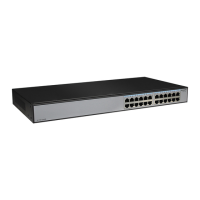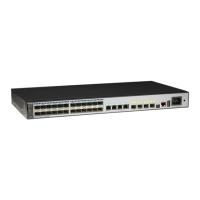NOTE
l Actual interval at which BFD packets are transmitted on the local switch = Max { configured interval
transmit-interval at which BFD packets are transmitted on the local switch, configured interval receive-
interval at which BFD packets are received on the peer switch }
l Actual interval at which BFD packets are received on the local switch = Max { configured interval transmit-
interval at which BFD packets are transmitted on the peer switch, configured interval receive-interval at
which BFD packets are received on the local switch }
l Actual time for detecting BFD packets = Actual interval at which BFD packets are received on the local
switch x Configured detection multiplier multiplier-value on the peer switch
For example:
l On the local switch, the configured interval at which BFD packets are transmitted is 200 ms; the configured
interval at which BFD packets are received is 300 ms; the detection multiplier is 4.
l On the peer switch, the configured interval at which BFD packets are transmitted is 100 ms; the interval at
which BFD packets are received is 600 ms; the detection multiplier is 5.
Then:
l On the local switch, the actual interval at which BFD packets are transmitted is 600 ms calculated by using
the formula max {200 ms, 600 ms}; the interval at which BFD packets are received is 300 ms calculated by
using the formula max {100 ms, 300 ms}; the detection period is 1500 ms calculated by multiplying 300
ms by 5.
l On the peer switch, the actual interval at which BFD packets are transmitted is 300 ms calculated by using
the formula max {100 ms, 300 ms}, the actual interval at which BFD packets are received is 600 ms calculated
by using the formula max {200 ms, 600 ms}, and the detection period is 2400 ms calculated by multiplying
600 ms by 4.
Step 7 (Optional) Prevent an interface from dynamically creating a BFD session.
After BFD for OSPF is configured, all interfaces on which neighbor relationships are Full in the
OSPF process will create BFD sessions. To prevent specific interfaces from being enabled with
BFD, disable these interfaces from dynamically creating BFD sessions.
1. Run:
quit
Return to the system view.
2. Run:
interface interface-type interface-number
The interface view is displayed.
3. Run:
ospf bfd block
An interface is prevented from dynamically creating a BFD session.
----End
4.9.3 Configuring BFD for OSPF on a Specified Interface
Configuring BFD for OSPF on a specified interface helps speed up OSPF convergence in the
case of an interface failure.
Context
After BFD for OSPF is configured on a specified interface and the interface becomes faulty, the
switch rapidly detects the fault and instructs OSPF to recalculate routes. This speeds up OSPF
convergence. When the OSPF neighbor relationship goes Down, the BFD session between OSPF
neighbors is dynamically deleted.
S6700 Series Ethernet Switches
Configuration Guide - IP Routing 4 OSPF Configuration
Issue 01 (2012-03-15) Huawei Proprietary and Confidential
Copyright © Huawei Technologies Co., Ltd.
123

